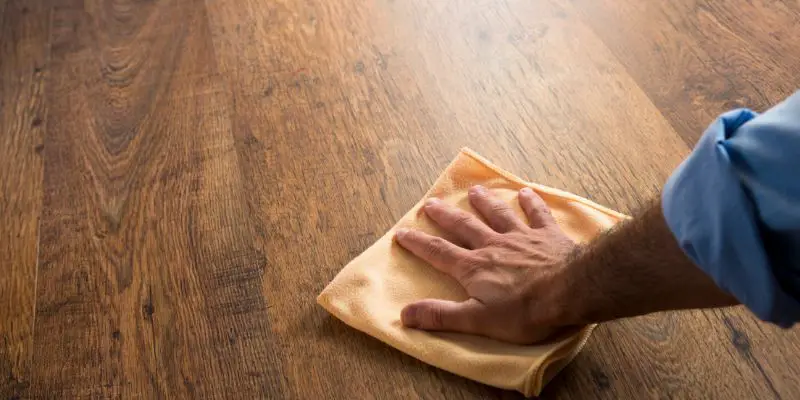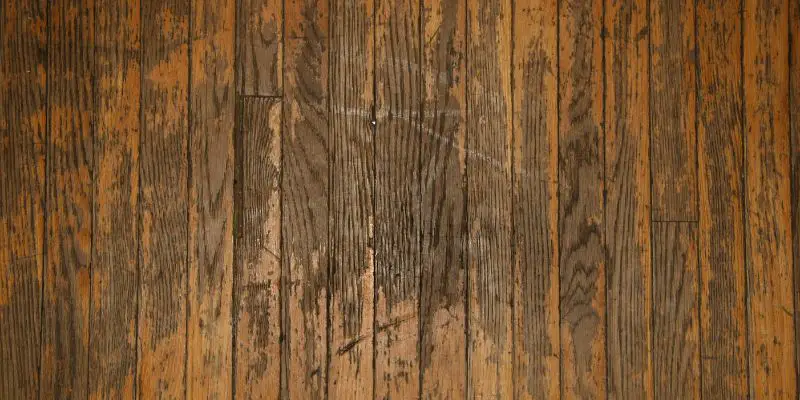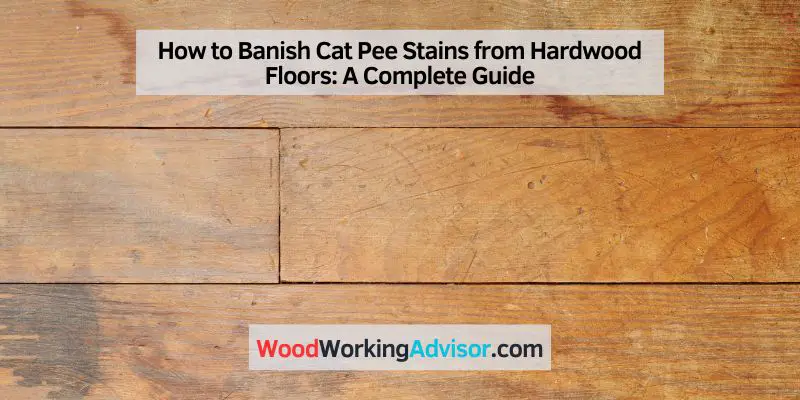To get cat pee stains out of hardwood floors, use a mixture of vinegar and water, then scrub the affected area. Are you struggling with cat pee stains on your beautiful hardwood floors?
Don’t worry, there’s a simple solution. Accidents happen, but with the right method, you can effectively remove those stubborn stains. We will guide you on how to get cat pee stains out of hardwood floors using a popular household ingredient.
By following our step-by-step instructions, you’ll be able to restore the natural beauty of your hardwood floors in no time. So let’s get started and bid farewell to those unsightly stains!
Knowledge Cat Pee Stains
Learn effective techniques to remove stubborn cat pee stains from hardwood floors effortlessly. Say goodbye to unsightly marks and odors with these simple steps.
What Causes Cat Pee Stains
Cat pee stains on hardwood floors can be frustrating to deal with. Understanding what causes these stains is the first step towards effectively removing them.
Unlike humans, cats have a strong sense of smell, and their urine contains ammonia and other chemicals that give it a distinct odor. When a cat urinates on a hardwood floor, the liquid can easily penetrate the wood’s surface and seep into the cracks and crevices.
| Cause: | Effect: |
| Cat marking territory | Leaves behind strong-smelling urine stains |
| Inappropriate litter box usage | Leads to accidents on the hardwood floor |
| Health issues | Can result in frequent accidents and urine stains |
Cats may mark their territory due to various reasons such as stress, anxiety, or the presence of other animals. In some cases, cats develop inappropriate litter box habits, choosing to urinate on the hardwood floor instead. Health issues, such as urinary tract infections or bladder stones, can also lead to frequent accidents and urine stains.
The Dangers Of Cat Pee Stains On Hardwood Floors
It’s important to address cat pee stains on hardwood floors promptly, as they can pose several dangers if left untreated.
- Permanent stains: Cat urine contains uric acid, which can discolor and stain hardwood floors if not removed promptly.
- Odor: The strong, pungent odor of cat urine can linger on the hardwood floor, making it unpleasant for both you and your furry friend.
- Damage to the wood: Over time, cat urine can damage the wood, causing it to warp, swell, or develop mold and mildew.
- Attracting other animals: The smell of cat urine can attract other animals, potentially leading to unwanted visitors or further damage.
By understanding the dangers associated with cat pee stains on hardwood floors, you can take the necessary steps to eliminate them effectively and protect the integrity of your flooring.

Preventing And Minimizing Cat Pee Stains
One of the keys to maintaining beautiful hardwood floors is preventing and minimizing cat pee stains. Dealing with cat urine can be a frustrating and unpleasant task, so it’s best to take proactive steps to prevent these accidents from happening in the first place. By following a few simple guidelines, you can create an environment that encourages your furry friend to use their litter box consistently and minimize the risk of cat pee stains on your hardwood floors.
Proper Cat Litter Box Placement
The placement of your cat’s litter box plays an important role in preventing accidents. Make sure to choose a location where your cat can easily access the litter box and feels comfortable using it. Avoid placing it in high-traffic areas or near their food and water bowls, as cats prefer some privacy when attending to their business.
If you have multiple floors in your home, consider having a litter box on each floor to make it convenient for your cat. In addition, it’s essential to keep the litter box clean and free from any bad odors that may deter your cat from using it. Regularly scoop out the waste and replace the litter every week to maintain a hygienic environment.
Regular Cleaning And Maintenance
In addition to proper cat litter box placement, regular cleaning and maintenance routines are crucial to preventing and minimizing cat pee stains on hardwood floors. Accidents can happen, and if your cat does have a little accident outside their litter box, it’s important to clean it up promptly.
Start by blotting up the urine with a paper towel or cloth to absorb as much liquid as possible. Avoid using any harsh chemicals or cleaners that can damage your hardwood floors. Instead, opt for natural products, such as a mixture of vinegar and warm water or specialized enzymatic cleaners designed to neutralize pet urine odors.
After cleaning up the mess, make sure to thoroughly dry the area to prevent any potential damage to the hardwood floors. You can use a fan or open windows to improve ventilation and expedite the drying process.
Identifying Cat Pee Stains On Hardwood Floors
Learn how to identify cat pee stains on hardwood floors and discover effective tips for getting rid of them. Protect your beautiful floors with these helpful solutions.
When it comes to maintaining the beauty of your hardwood floors, identifying and removing cat pee stains is crucial. Not only can cat urine leave unsightly stains on your floors, but it can also emit a strong odor that is difficult to eliminate. In this section, we will discuss how to identify cat pee stains on hardwood floors, both visible stains and those that are invisible to the naked eye.
Visible Stains And Odors
Visible stains on hardwood floors are usually easy to spot. You’ll notice discoloration or dark spots on the surface of the wood, often accompanied by a strong smell. If you come across such stains, it’s important to take immediate action in order to prevent any long-term damage to your floors.
To tackle visible cat pee stains on your hardwood floors, follow these steps:
- Start by wiping up any fresh urine with a paper towel or absorbent cloth. Pat the affected area gently, ensuring you don’t spread the stain further.
- Next, prepare a solution of one part white vinegar to two parts water. Vinegar is an effective natural cleaner that can help break down the enzymes in cat urine.
- Dip a clean cloth or sponge into the vinegar solution and gently scrub the stained area. Be sure to work in small sections and avoid saturating the wood.
- After scrubbing, rinse the area with clean water to remove any residual vinegar. Then, use a dry cloth or towel to absorb the moisture.
- If the stain persists or the odor lingers, you may need to repeat the process or consider using a specialized pet urine cleaner.
Using UV Light To Detect Invisible Stains
Unfortunately, not all cat pee stains are visible to the naked eye. Some urine can seep into the wood and leave behind invisible stains that may go unnoticed for months or even years. However, there is a helpful tool you can use to identify these hidden stains: a UV light.
By shining a UV light over your hardwood floors, you can easily detect any urine stains that are not visible under normal lighting conditions. The enzymes in cat urine cause it to glow bright green under UV light, making it easy to pinpoint affected areas.
To use a UV light to detect invisible cat pee stains, follow these steps:
- Turn off all lights in the room to ensure complete darkness.
- Hold the UV light parallel to the floor, approximately 1-2 feet above the surface.
- Slowly scan the room, paying close attention to any areas that appear fluorescent green.
- Once you’ve identified the invisible stains, you can proceed with cleaning them using the steps mentioned earlier.
Remember, it’s crucial to address both visible and invisible cat pee stains promptly to maintain the integrity and beauty of your hardwood floors. With these techniques, you can effectively identify and remove cat pee stains, helping you keep your floors looking their best for years to come.
Removing Fresh Cat Pee Stains
Cat urine stains on hardwood floors can be a nuisance to deal with, but with the right techniques, you can effectively remove them and restore the beauty of your flooring. In this section, we will explore two effective methods for tackling fresh cat pee stains: blotting and absorbing the urine, and using homemade enzymatic cleaners.
Blotting And Absorbing The Urine
When you notice a fresh cat pee stain on your hardwood floor, the first step is to act quickly by blotting and absorbing the urine. This method helps prevent the stain from seeping further into the wood, reducing the chances of permanent damage.
- Start by placing a few layers of clean paper towels or absorbent cloths over the stain.
- Apply gentle pressure on the towels to soak up as much urine as possible. Avoid rubbing the stain, as this may spread it further.
- Continue blotting with fresh towels until no more urine is being absorbed. Remember to discard the soiled towels properly to avoid any lingering odor.
Once you have successfully removed the excess urine, it’s time to tackle any remaining stain and odor using homemade enzymatic cleaners.
Using Homemade Enzymatic Cleaners
Homemade enzymatic cleaners are an effective and natural way to break down and eliminate cat urine stains and odors from your hardwood floors. These cleaners work by using enzymes to neutralize the odor-causing bacteria and ultimately eliminate both the stain and the smell.
Here’s a simple recipe for a homemade enzymatic cleaner:
| Ingredients | Instructions |
| Vinegar | In a spray bottle, mix equal parts white vinegar and water. |
| Baking Soda | Sprinkle baking soda generously over the urine stain. |
| Lemon Juice | Squeeze fresh lemon juice over the baking soda. |
| Enzyme Cleaner | Spray the vinegar and water solution over the stained area, allowing it to soak in for 5-10 minutes. |
| Blot the area gently with a clean cloth to remove excess moisture and let it air dry. |
By using this homemade enzymatic cleaner, you can effectively neutralize the odor and remove the remaining stain from your hardwood floors. Remember to always test any cleaner on a small, inconspicuous area first to ensure it doesn’t damage or discolor the wood.
With these simple yet effective methods for removing fresh cat pee stains from hardwood floors, you can keep your floors clean, odor-free, and looking their best. So, next time your feline friend has an accident, don’t panic – tackle the problem head-on and restore the beauty of your hardwood floors.
Dealing With Old And Stubborn Cat Pee Stains
To effectively eliminate old and stubborn cat pee stains from hardwood floors, follow these simple steps. Begin by blotting the urine with paper towels, then use a mixture of vinegar and water to dilute the stain. Scrub the area gently with a soft cloth, and finally, rinse the spot with clean water.
Sanding And Refinishing The Floor
If you’re dealing with old and stubborn cat pee stains on your hardwood floors, sanding and refinishing might be your best option. This process involves removing the top layer of the wood to get rid of the stains and then applying a new finish to restore its original beauty. While sanding and refinishing can be time-consuming, it is often the most effective method for eliminating deep-set cat pee stains.
Here’s a step-by-step guide to sanding and refinishing your hardwood floors to tackle those pesky stains:
- Gather the necessary tools and materials: Before you start, make sure you have all the supplies you’ll need. This includes a floor sander, sandpaper in varying grits, a vacuum cleaner, a broom, a tack cloth, and a polyurethane finish.
- Prepare the room: Clear the room of any furniture, rugs, or obstacles. This will allow you to move around freely while sanding the floor.
- Sand the floor: Start with coarse-grit sandpaper to remove the old finish and stains. Gradually work your way through finer grits to achieve a smooth and even surface. Make sure to follow the wood grain and avoid applying too much pressure, as this can damage the floor.
- Remove the dust: After sanding, thoroughly vacuum the floor to remove any dust and debris. Use a broom or a tack cloth to get rid of any remaining particles.
- Apply the finish: Once the floor is clean and dust-free, apply a polyurethane finish to protect and enhance the wood. Follow the manufacturer’s instructions for proper application and drying times. Consider applying multiple coats for added durability.
- Allow for curing: Let the finish cure for the recommended amount of time before placing furniture or rugs back on the floor. This will ensure a durable and long-lasting result.
Professional Stain Removal Techniques
If sanding and refinishing seems too daunting or time-consuming, you can enlist the help of professionals who specialize in stain removal. These experts have access to advanced tools and techniques that can effectively eliminate even the most stubborn cat pee stains without requiring you to undertake the arduous refinishing process.
Here are some professional stain removal techniques commonly used:
| Technique | Description |
|---|---|
| Enzyme-based cleaners | These cleaners contain enzymes that break down the uric acid crystals in cat urine, effectively eliminating the stain and odor. |
| Oxidizing agents | Oxidizing agents, such as hydrogen peroxide, can help remove tough stains by breaking down the compounds responsible for the discoloration. |
| Blacklight detection | Professionals often use blacklights to locate hidden or dried cat pee stains that are not visible to the naked eye. This helps them target specific areas for treatment. |
Keep in mind that professional stain removal services may come at a cost, but they can save you time, effort, and potential damage to your hardwood floors. It’s essential to choose a reputable and experienced professional to ensure effective and safe stain removal.

Preventing Future Cat Pee Stains
When it comes to maintaining the beauty and durability of your hardwood floors, preventing future cat pee stains is crucial. Implementing the right strategies can help keep your floors clean and protect them from potential damage. Here are a few effective methods you can use:
Behavioral Training And Enrichment
Proper behavioral training and enrichment for your cat can greatly reduce the chances of future accidents on your hardwood floors. Here’s what you can do:
- Establish a consistent litter box routine and make sure it is easily accessible to your cat.
- Keep the litter box clean, scooping it daily and replacing the litter regularly.
- Provide multiple litter boxes in different areas of your home, especially if you have a large space.
- Consult with a professional cat behaviorist to address any underlying issues that may be causing your cat to pee outside the litter box.
- Enrich your cat’s environment with toys, scratching posts, and perches to prevent boredom and stress.
Using Repellents And Deterrents
To discourage your cat from peeing on your hardwood floors, you can use repellents and deterrents that are safe for both your cat and your floors. Consider the following options:
- Use natural citrus sprays or essential oils, as cats dislike the smell of citrus.
- Place aluminum foil or double-sided tape on areas where your cat tends to pee as they dislike the texture.
- Invest in motion-activated sensor devices that emit harmless sounds or sprays when your cat approaches the protected areas.
- Consider using commercial cat repellent sprays or powders specifically designed to deter cats from marking their territory.
By implementing these preventative measures, you can effectively reduce the risk of future cat pee stains on your hardwood floors. Remember to be patient and consistent with the training and enrichment activities you introduce to your cat. With time and effort, you’ll create an environment where accidents are less likely to occur.
Conclusion
To conclude, removing cat pee stains from hardwood floors doesn’t have to be a daunting task. By following the steps outlined in this blog post, you can effectively eliminate the odor and restore the beauty of your floors. Remember to act quickly, be patient, and use appropriate cleaning solutions.
With a little effort and care, your hardwood floors will be stain-free and fresh-smelling once again. Say goodbye to cat pee stains and hello to clean, beautiful floors!


